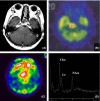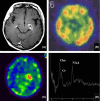A case of multiple radiation-induced gliomas 24 years after radiation therapy against pituitary adenoma
- PMID: 27099727
- PMCID: PMC4831383
- DOI: 10.1002/ccr3.521
A case of multiple radiation-induced gliomas 24 years after radiation therapy against pituitary adenoma
Abstract
We treated a case in which multiple astrocytomas of varying grades developed in the irradiation field 24 years after radiation therapy. Differentiation from radiation necrosis based on presurgical diagnostic imaging was difficult; therefore, we feel it is essential to aggressively pursue histological diagnoses to select the optimal treatment method.
Keywords: autopsy; multiple radiation‐induced gliomas; pituitary adenoma; temozolomide.
Figures





Similar articles
-
Glioma arising after radiation therapy for pituitary adenoma. A report of four patients and estimation of risk.Cancer. 1993 Oct 1;72(7):2227-33. doi: 10.1002/1097-0142(19931001)72:7<2227::aid-cncr2820720727>3.0.co;2-i. Cancer. 1993. PMID: 8374881
-
Glioma occurrence after sellar irradiation: case report and review.Neurosurgery. 1998 Jan;42(1):172-8. doi: 10.1097/00006123-199801000-00038. Neurosurgery. 1998. PMID: 9442520 Review.
-
Temozolomide retreatment in a recurrent prolactin-secreting pituitary adenoma: Hormonal and radiographic response.J Oncol Pharm Pract. 2016 Jun;22(3):517-22. doi: 10.1177/1078155215569556. Epub 2015 Jan 23. J Oncol Pharm Pract. 2016. PMID: 25616657
-
[Malignant astrocytoma following radiotherapy in pituitary adenoma: case report].No Shinkei Geka. 1989 Aug;17(8):783-8. No Shinkei Geka. 1989. PMID: 2685639 Review. Japanese.
-
Feasibility and outcome of re-irradiation in the treatment of multiply recurrent pituitary adenomas.Pituitary. 2014 Dec;17(6):539-45. doi: 10.1007/s11102-013-0541-x. Pituitary. 2014. PMID: 24272035
Cited by
-
Defining the molecular features of radiation-induced glioma: A systematic review and meta-analysis.Neurooncol Adv. 2021 Aug 12;3(1):vdab109. doi: 10.1093/noajnl/vdab109. eCollection 2021 Jan-Dec. Neurooncol Adv. 2021. PMID: 34859225 Free PMC article. Review.
References
-
- Kato, A. , Kayama T., Sakurada K., Saino M., and Kuroki A.. 2002. Radiation induced glioblastoma: a case report. Brain Nerve 52:413–418. - PubMed
-
- Alexander, M. J. , DeSalles A. A., and Tomiyasu U.. 1998. Multiple radiation‐induced intracranial lesions after treatment for pituitary adenoma. J. Neurosurg. 88:111–115. - PubMed
-
- Shimizu, H. , Fujiwara K., Kobayashi S., and Kitahara M.. 1994. A case of paraventricular anaplastic astrocytoma following radiation therapy for craniopharyngioma. Neurol. Surg. 22:357–362. - PubMed
-
- Suda, Y. , Mineura K., Kowada M., and Ohishi H.. 1989. Malignant astrocytoma following radiotherapy for pituitary adenoma: case report. Neurol. Surg. 17:783–788. - PubMed
-
- Tamura, M. , Misumi S., Kurosaki S., Shibasaki T., and Ohye C.. 1992. Anaplastic astrocytoma 14 years after radiotherapy for pituitary adenoma. Neurol. Surg. 20:493–497. - PubMed
Publication types
LinkOut - more resources
Full Text Sources
Other Literature Sources

